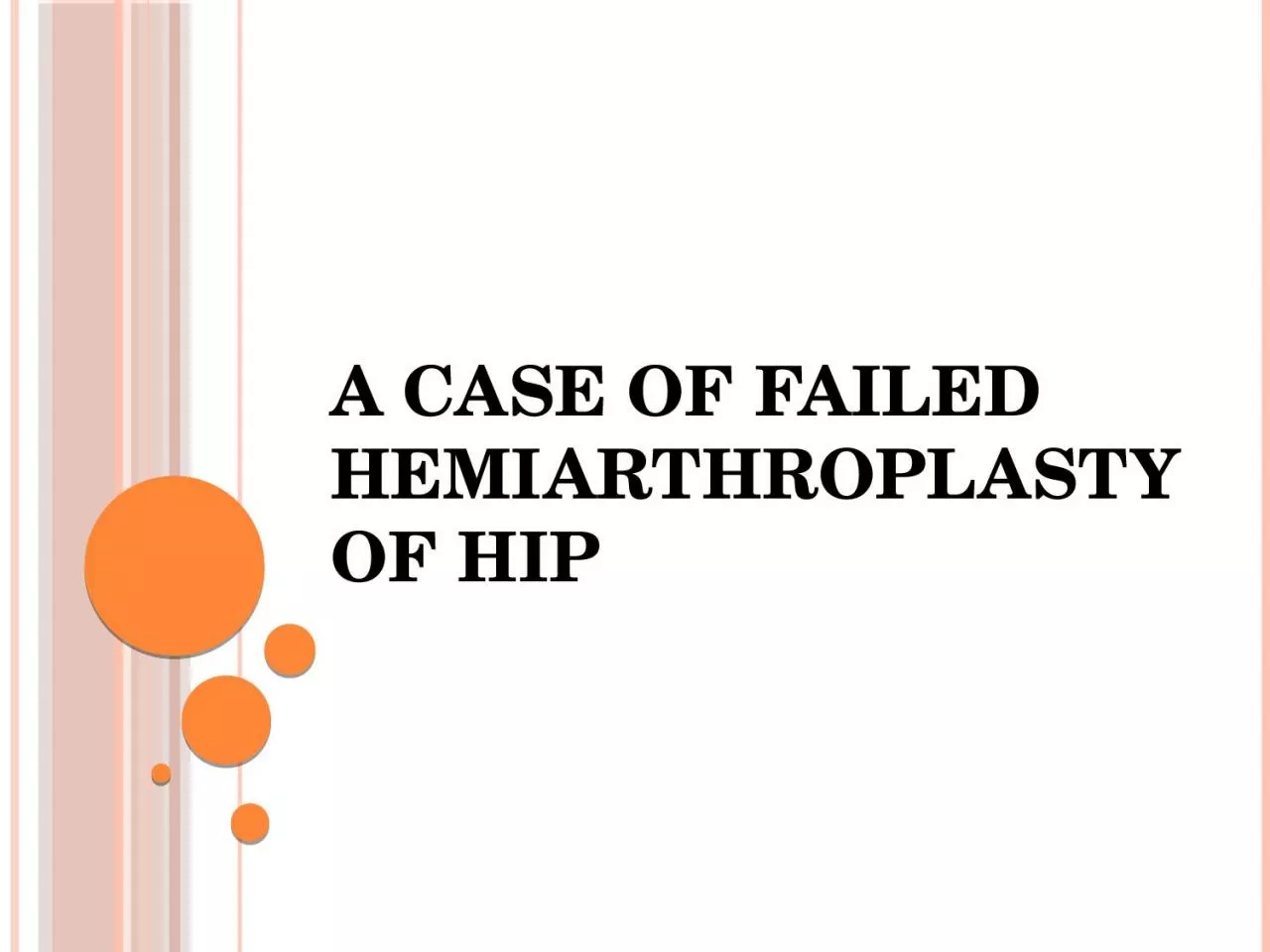

HISTORY 58M complaints of pain in the left hip region since 3 years aggravated over the past 23 months No history of trauma or fall History of joint replacement done 10 years ago No co morbidities reported ID: 1034352
Download Presentation The PPT/PDF document "A CASE OF FAILED HEMIARTHROPLASTY OF HIP" is the property of its rightful owner. Permission is granted to download and print the materials on this web site for personal, non-commercial use only, and to display it on your personal computer provided you do not modify the materials and that you retain all copyright notices contained in the materials. By downloading content from our website, you accept the terms of this agreement.
1. A CASE OF FAILED HEMIARTHROPLASTY OF HIP
2. HISTORY58/M, complaints of pain in the left hip region since 3 years, aggravated over the past 2-3 monthsNo history of trauma or fall.History of joint replacement done 10 years agoNo co morbidities reported
3. on examination14-15 cms old healed scar seen along the postero-lateral portion of the left hip joint.No scar dehiscence or tenderness presentNo sinus/ discharge/ induration presentThe patient had painful limp on attempting to walkRange of motion-MOVEMENTLEFT RIGHT(NORMAL)FLEXION90120EXTENSION520ABDUCTION1540ADDUCTION2025INT.ROTATION AT 90 FLEXION3045EXT.ROTATION AT 90 FLEXION3045
4. PRE-OPERATIVE X-RAYBROKEN IMPLANTTHIN RIM OF ACETABULUM
5. BROKEN IMPLANTTHICK CEMENT MANTLEOSTEOLYSIS
6. BROKEN IMPLANT
7. PRE-OP PREPARATIONSRoutine lab investigations- to rule out infectionHB-13.8GM%TLC- 7400/cu.mmCRP (Q)- 5.6 mg/L.ESR-12mmTemplating was doneHip aspiration was done and sent for culture which showed no growth of any organism.Bone cement was kept readyBone Grafting consent was taken and kept ready if the need arises
8. INTRA-OPINFECTION WAS RULED OUT CLINICALLY USING INTRA-OP FINDINGSSoft tissue was healthy.Bone was undamaged and healthyThere was no presence of any sinus, discharge or any collectionHistopathology and culture/sensitivity samples of the tissue were sent.Other methods to rule out infection using kits (like leucocyte esterase test, alpha defensin test) can also be used.
9. CHALLENGES MET INTRA-OPRuling Out Of InfectionPlanning Of OsteotomyRemoving The Cement MantleRemoving The StemStable Fixation Of OsteotomyHaemorrhageEnsuring Minimal Bone LossBig Inventory Of The Instruments And Implants
10. DURING THE SURGERY
11. EXTENDED TROCHANTERIC OSTEOTOMY WAS DONETO REMOVE THE CEMENT
12.
13. FEMORAL CANAL CLEARED OF ALL CEMENT DEBRIS
14. REMOVING THE METALLOSIS
15. INTRA-OPERATIVE FINDINGSMETALLOSIS OF THE SOFT TISSUE
16. HISTOPATHOLOGY REPORT
17. THE ORIGINAL IMPLANT
18. THE NEW IMPLANT GEN-X LONG STEM STAINLESS STEEL (H.A. COATED)
19. POST-OPERATIVE X-RAY
20. THE OSTETOMIZED FLAP FIXED IN PLACE USING DEPUY SYNTHASE CABLESANATOMICAL REDUCTION OBTAINED
21. Post-op rehabilitationBed side sitting and quadriceps and knee range of motion exercises were started from the third day.Patient was kept Non weight bearing and ambulation with walker for three weeks.He was strictly advised to avoid sitting cross-legged, squatting and strictly walk on flat surfaces and planes for atleast 3-4 weeks of the post operative period.Patient was started with full weight bearing after 6 weeks.
22.
23. THANK YOU…